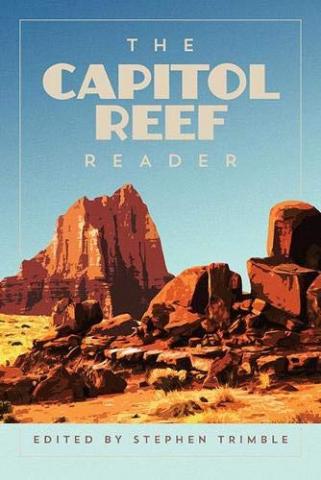We all know what incredible cauldrons of beauty and history national parks hold for visitors to marvel at. You can view them as libraries of natural and cultural history. And like most libraries, you can get lost in the stacks if you don’t have a guide.
Stephen Trimble has put together the guide you need to more fully appreciate Capitol Reef National Park in Utah. It’s not your typical national park guidebook. No trail, dining, or lodging information. Rather, The Capitol Reef Reader offers an incredible wealth of information in the essays Trimble has pulled together for this collection. Essays by the likes of Clarence Dutton who traveled the Southwest with Major John Wesley Powell, by Ed Abbey, and by that literary conservation giant, Wallace Stegner.
But there also are pieces by names we’re not all familiar with. Greg Gordon describes Capitol Reef as a “Landscape of Desire,” Jonathan Thow digs into the park’s history with uranium, and Steven R. Sims teaches us about the Fremont culture that long ago lived in this landscape.
Though the anthology is not a collection of where-to-go and what-to-see essays, it offers the grit from which Capitol Reef rose up. Not just the geology -- though there's plenty there to ponder in awe -- but also the human connections to this red-rock wonder. Even Butch Cassidy makes an appearance.
Through their essays, the authors share their wisdom on the cultures that called the Capitol Reef region home, instruct us on the rich and unique geology there, and describe the incredible effort that went into creating Capitol Reef National Park.
In today's political climate, the book also carries something of a subliminal warning that park lands are not always inviolate simply because they're in the National Park System. When he was working on his master's thesis -- appropriately called Capitol Reef: The Forgotten National Park -- at Utah State University, Jonathan Thow recounted how the uranium frenzy in the 1950s actually led to Capitol Reef National Monument, as it was known then, being opened to prospecting for that radioactive ore.
After 18 months of prospecting in and around the monument, then-Superintendent Charles Kelly beseeched his bosses in the National Park Service to close the park to prospectors.
Hundreds of prosectors have searched every inch of ground and spent thousands of dollars blasting out tunnels and prospect holes. Every foot of ground has been staked and restaked. And yet not one pound of uranium has been extracted and sold, for the simple reason that it does not exist except in one very limited locality, and even that is not extensive enough to be worth mining.
Part of the beauty of The Capitol Reef Reader is that there's no one central thread you need to follow as you turn the pages. Rather, Trimble took the richness of 160 years worth of essays he painstakingly tracked down and considered for inclusion and wove a rich quilt of literature centered on the park. You can jump back and forth through the more than 300 pages depending on what aspect you want to explore or savor. And as you do, you have about 100 gorgeous photos of the park to help place your mind there.
If there's a troubling aspect to the book, it's that those who read it will want to visit Capitol Reef. Though part of Utah's Mighty 5® tourism campaign built around the five national parks in the state, Capitol Reef might be viewed as the runt of the litter when it comes to visitors. But that, too, is the beauty of the park. You can find solitude within its red-rock resplendence.
Traveler bonus: This week's National Parks Traveler podcast features an interview with Trimble that explores his approach to this project and the wonders he uncovered. You can find it here.





Comments
That's a nice review. Thanks, Kurt!
Going to Capital Reef in 2 weeks would like to talk to Mr Trimble and see if he can tell me a few places to try and go. We have a Camry that is not a Suburu?
Thank You
Dale L Hamblin